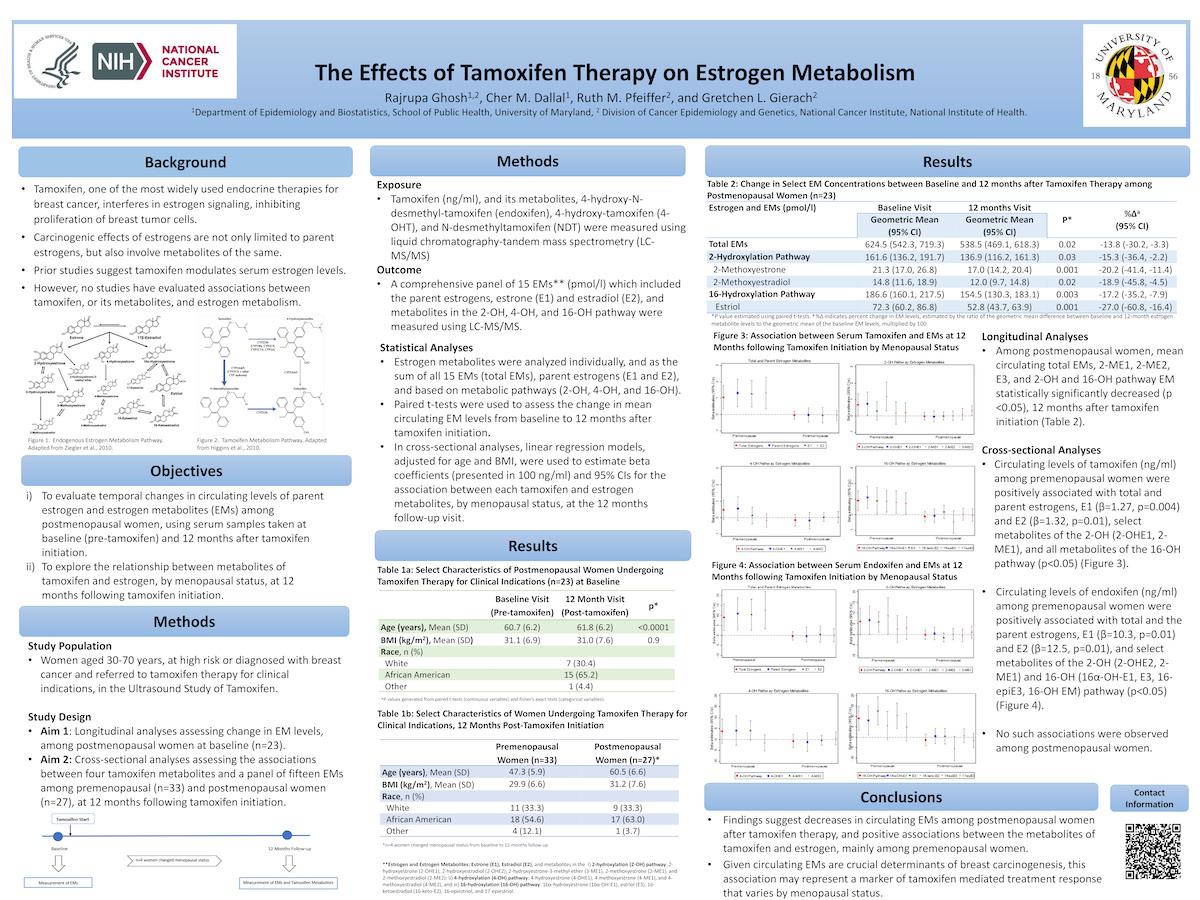
Poster # 7
Title: The Effects of Tamoxifen Therapy on Estrogen Metabolism
Presenting Author: Rajrupa Ghosh (UMD SPH Doctoral Student in Epidemiology and Biostatistics)
Authors: Cher M. Dallal, Associate Professor, Department of Epidemiology and Biostatistics, School of Public Health, University of Maryland; Ruth M. Pfeiffer, Senior Investigator, Biostatistics Branch, Division of Cancer Epidemiology and Genetics, National Cancer Institute, National Institute of Health; Gretchen L. Gierach, Chief and Senior Investigator, Integrative Tumor Epidemiology Branch, Division of Cancer Epidemiology and Genetics, National Cancer Institute, National Institute of Health
Faculty Mentors: Cher Dallal
Primary Category: Cancer Prevention and Control
Secondary Category: Cancer Prevention and Control
Background: Prior studies suggest tamoxifen modulates serum estrogen levels, however, no studies have evaluated associations between tamoxifen, or its metabolites, and estrogen metabolism using serial serum samples.
Goal: The overall objective was to improve the etiologic understanding of the role of tamoxifen and its metabolites on estrogen metabolism, an important determinant of breast carcinogenesis.
Objectives: (1) To evaluate the temporal changes in serum concentrations of parent estrogen and EMs among postmenopausal women, using serum samples taken at baseline (pre-tamoxifen) and 12 months after tamoxifen initiation, and (2) To explore the relationship between the metabolites of tamoxifen and estrogen, by menopausal status, at 12 months following tamoxifen initiation.
Approach/Methods: Serum concentrations of 15 estrogens and estrogen metabolites (EMs) and four tamoxifen metabolites were measured using liquid chromatography-tandem mass spectrometry among women diagnosed with, or at high risk for breast cancer. In longitudinal analyses among postmenopausal women at baseline (n=23), changes in EMs, 12 months after tamoxifen initiation, were assessed with paired t-tests. In a cross-sectional analysis conducted at the 12-month follow-up visit, associations between four tamoxifen metabolites (tamoxifen, endoxifen, 4-hydroxy-tamoxifen, N-desmethyltamoxifen) and EMs, analyzed individually and grouped by metabolic pathways (2-OH, 4-OH, and 16-OH), were assessed using linear regression models among premenopausal (n=33) and postmenopausal women (n=27).
Results: Among postmenopausal women, mean circulating total EMs, 2-ME1, 2-ME2, E3, and 2-OH and 16-OH pathway EM statistically significant decreased (p <0.05), 12 months after tamoxifen initiation. In cross-sectional analyses, significant findings between the tamoxifen metabolites and EM were mainly observed among premenopausal women. At the 12-month follow-up visit, circulating levels of tamoxifen (ng/ml) were positively associated with the parent estrogens, estrone (β=1.27, p=0.004) and estradiol (β=1.32, p=0.01), select metabolites of the 2-OH (2-OHE1, 2-ME1), and all metabolites of the 16-OH pathway (p<0.05). Similarly, endoxifen (ng/ml) was positively associated with estrone (β=10.3, p=0.01) and estradiol (β=12.5, p=0.01). Of the metabolite pathways, positive associations were noted mainly between endoxifen (ng/ml) with select metabolites of the 2-OH (2-OHE2, 2-ME1) and 16-OH (16α-OH-E1, E3, 16-epiE3, 16-OH EM) pathway (p<0.05). No patterns were noted among postmenopausal women.
Importance to Public Health: Our findings suggest tamoxifen therapy decreases circulating EMs among postmenopausal women and a positive association between metabolites of tamoxifen and estrogen,mainly among premenopausal women. As high circulating EMs are crucial determinants of breast carcinogenesis, this association may represent a marker of tamoxifen mediated treatment response that varies by menopausal status.
